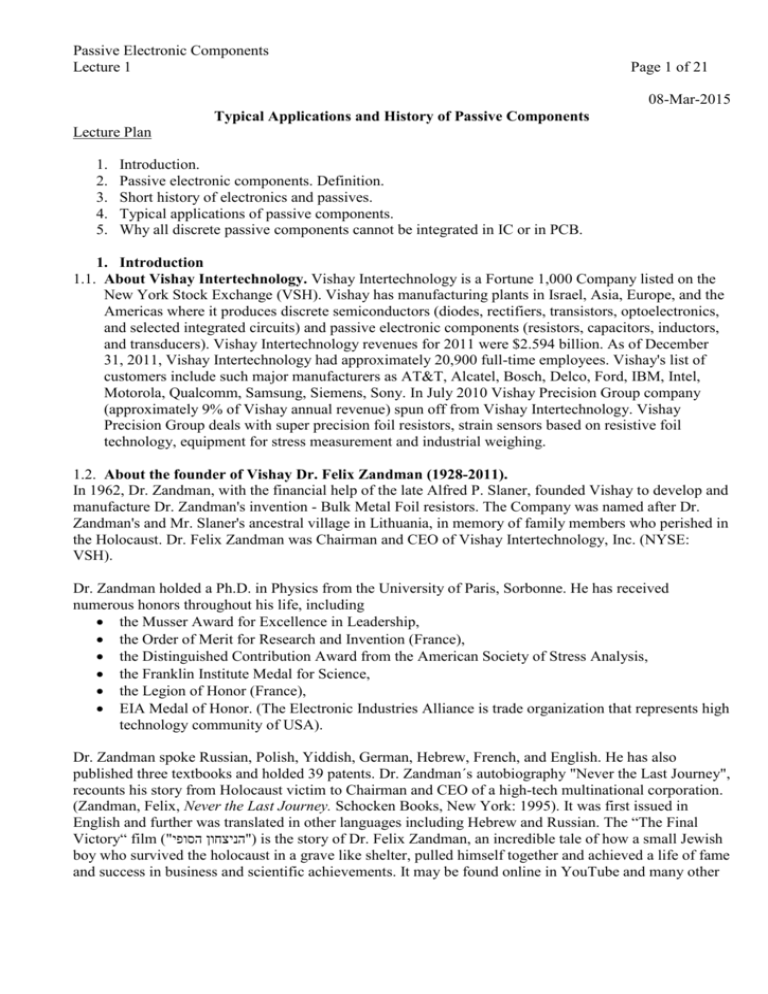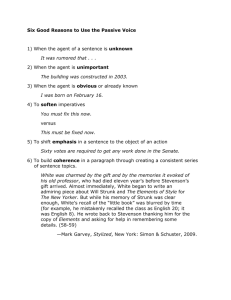L 01 Components history. Engineering calculations
advertisement

Passive Electronic Components Lecture 1 Page 1 of 21 08-Mar-2015 Typical Applications and History of Passive Components Lecture Plan 1. 2. 3. 4. 5. Introduction. Passive electronic components. Definition. Short history of electronics and passives. Typical applications of passive components. Why all discrete passive components cannot be integrated in IC or in PCB. 1. Introduction 1.1. About Vishay Intertechnology. Vishay Intertechnology is a Fortune 1,000 Company listed on the New York Stock Exchange (VSH). Vishay has manufacturing plants in Israel, Asia, Europe, and the Americas where it produces discrete semiconductors (diodes, rectifiers, transistors, optoelectronics, and selected integrated circuits) and passive electronic components (resistors, capacitors, inductors, and transducers). Vishay Intertechnology revenues for 2011 were $2.594 billion. As of December 31, 2011, Vishay Intertechnology had approximately 20,900 full-time employees. Vishay's list of customers include such major manufacturers as AT&T, Alcatel, Bosch, Delco, Ford, IBM, Intel, Motorola, Qualcomm, Samsung, Siemens, Sony. In July 2010 Vishay Precision Group company (approximately 9% of Vishay annual revenue) spun off from Vishay Intertechnology. Vishay Precision Group deals with super precision foil resistors, strain sensors based on resistive foil technology, equipment for stress measurement and industrial weighing. 1.2. About the founder of Vishay Dr. Felix Zandman (1928-2011). In 1962, Dr. Zandman, with the financial help of the late Alfred P. Slaner, founded Vishay to develop and manufacture Dr. Zandman's invention - Bulk Metal Foil resistors. The Company was named after Dr. Zandman's and Mr. Slaner's ancestral village in Lithuania, in memory of family members who perished in the Holocaust. Dr. Felix Zandman was Chairman and CEO of Vishay Intertechnology, Inc. (NYSE: VSH). Dr. Zandman holded a Ph.D. in Physics from the University of Paris, Sorbonne. He has received numerous honors throughout his life, including the Musser Award for Excellence in Leadership, the Order of Merit for Research and Invention (France), the Distinguished Contribution Award from the American Society of Stress Analysis, the Franklin Institute Medal for Science, the Legion of Honor (France), EIA Medal of Honor. (The Electronic Industries Alliance is trade organization that represents high technology community of USA). Dr. Zandman spoke Russian, Polish, Yiddish, German, Hebrew, French, and English. He has also published three textbooks and holded 39 patents. Dr. Zandman´s autobiography "Never the Last Journey", recounts his story from Holocaust victim to Chairman and CEO of a high-tech multinational corporation. (Zandman, Felix, Never the Last Journey. Schocken Books, New York: 1995). It was first issued in English and further was translated in other languages including Hebrew and Russian. The “The Final Victory“ film (" )"הניצחון הסופיis the story of Dr. Felix Zandman, an incredible tale of how a small Jewish boy who survived the holocaust in a grave like shelter, pulled himself together and achieved a life of fame and success in business and scientific achievements. It may be found online in YouTube and many other Passive Electronic Components Lecture 1 Page 2 of 21 sources (see for example https://vimeo.com/47732085 in Hebrew and http://learnmitzvot.com/showsubvideos.php?id=118 in Russian). 1.3. About the lecturer. Dr. Michael Belman is Research and Development Group Leader in Beer-Sheva plant of Vishay Israel Ltd., inventor of 4 patents in passive components field. He graduated with honors from Department of Engineering Physics of Kharkov State Polytechnical University, Ukraine in 1974, received his Ph.D. from Riga Technical University, Latvia in 1986, and is with Vishay Israel Ltd. from 1991. 1.4. About the course. This course is intended to give the students an understanding of: Passive electronic components constructions, features, modern design, electrical, thermal, and mechanical properties. Application of passive electronic components in the modern electronics (selection, mounting). 2. Characteristics of passive components. Definition: passive component is any electronic device that does not introduce gain or does not have directional functions. Passive components may be linear or non-linear. Physical parameters of linear (in real life “almost liner”) passive components - resistors, capacitors, and inductors - do not depend significantly on voltage applied to their terminals or electrical current forced across them. It is not so when essentially non-linear components (varistors, thermistors, fuses) are concerned. There is some "grey" area of interchangeability between active and passive components. For example: The Field Effect Transistor (active component) may be used as a Voltage Controlled Resistor. Source and Drain will be “resistor” terminals, control voltage should be applied between Gate and Source terminals. Variable Capacitance Diode or Varicap (active component) may replace metal plate variable capacitor. Passive Electronic Components Lecture 1 Page 3 of 21 Incandescent bulb (that may be regarded as passive component) may serve as a current stabilizer. It may be used as Automatic Gain Control (AGC) element too. The classic example is Wien bridge circuit in Audio Oscillator HP 200A developed by Bill Hewlett and Dave Packard in 1938. Varistor (passive component) is commonly used as surge suppressor (Voltage Clamping Device). It acts very similar to symmetrical Zener diode. Electrolytic capacitor (passive component) is semi-conductive and therefore may rectify alternating current as a diode. Anyhow, the reverse voltage mode without current limitation may result in capacitor damage and commonly is not allowed. Let us note that the equations that express conductance and capacitance of solid electrically conductive bodies through electric field, and their inductance through magnetic field look very similar: 1 i G R V S a E dl b E ds q C V E dS S E dl S S N H ds N L S i H dl C (1) Passive Electronic Components Lecture 1 G – conductance; R – resistance; i – current; V – voltage; – conductivity; E – electrical field; S – cross-section of resistive element; a, b – terminal points. Page 4 of 21 C – capacitance; q – charge; – permittivity; S – positive electrode surface; S – negative electrode surface. L – coil inductance; – flux; N – number of turns - permeability; H - magnetic field, ( B H – magnetic induction); S – internal area of each turn; C – closed field line. Each of the equations (1) includes only geometric parameters and respective physical constant of the medium. 3. Historical excursus. Inventions of principal passive components: Capacitor – 1745; Resistor – 1827; Inductor – 1831. Evolution of electronic components (including passive components). It follows three directions: Smaller size. Lower cost. Higher performance. Let us compare for example radio sets manufactured in different times. Crosley TRIRDYN REGULAR. Regenerative 3-tubes Reflex Receiver. The Crosley Radio Corporation, (1925), 54cm length, $50, (approximately $668 in 2015). Passive Electronic Components Lecture 1 Page 5 of 21 Regency TR-1 4 transistors Super-Heterodyne. Texas Instruments of Dallas, Texas and Industrial Development Engineering Associates (I.D.E.A.) of Indianapolis, Indiana. (1954), 12.7 cm length, $50 (approximately $434 in 2015). XIBOMAN AS-875 Mini FM Scan Radio. (2015), 8.8 cm length, $3.5. Smaller sizes and higher performance of newer radios is a commonplace. Price comparison is the following: TRIRDYN REGULAR. Regenerative 3-tubes Reflex Receiver manufactured by Crosley Radio Corporation (USA). Price $50 in 1925 is approximately $668 in 2015. The first 4-transistor AM radio TR-1 was manufactured by Regency. Its price was $50 in 1954 is approximately $434 in 2015. Nowadays (2015) AM/FM portable radio + headphones price starts from about $3.5. Passive Electronic Components Lecture 1 Page 6 of 21 Radio Set Price 800 USD (2015) 700 668 600 434 500 400 300 200 100 3.5 0 This progress has become possible as the result of perfection of electronic components (both active and passive). Let us consider a 1W resistors for example. 1W resistors: Axial leaded Chip 6.5 0.6 22.5 6.3 Passive Electronic Components Lecture 1 Page 7 of 21 4. Applications of passive components. Passive components applications Analog signal processing Digital signal processing EMI supressing Power management Amplification (feedback, load, bias) RCL Pulling up and pulling down R Noise suppression in signal line (common mode choke) L Current sensing (voltage regulator, motor driver) R HF tuning and filtering (resonant circuit) CL Impedance matching R Noise suppression in power line (ferrite bead, bypass cap) LC Energy accumulation (inductor and cap in DC-DC convertor) LC LF filtering (active and passive filters) RCL Current limiting (in LED, laser, Zener) R Coupling of amplifier stages C Attenuation and impedance matching R Current sensing (instruments) R Timing RC Passive components in 2003 constituted are about 80% of BOM (Bill of Materials) count, occupied about 60% of PCB area and constituted about 20% of BOM cost 6). Passive components part count on PCB, % 100 80 60 40 20 0 1984 1987 1990 1993 Passive Electronic Components Lecture 1 Page 8 of 21 DDR3-1333 SDRAM (see picture below) comprises 4 active components and 68 passive (or 94%) on the shown side of the PCB. Passive components consumption in some products. Car electronics – 3400. PC – 2178 units. LCD TV – 2100. iPhone 6 Plus – about 1100. Game console – 1020. Digital camera – 839. iPod – 230. Passive components count in typical PC motherboard 700 600 500 400 300 200 100 0 600 440 345 252 124 486 Pentium Processor Type 486 Pentium Pentium II Pentium III Pentium 4 (Willamette) Pentium II Pentium III Pentium IV Transistors on chip 1.2M 3.2M 7.5M 28M 42M External passives count 124 252 345 440 600 Passive Electronic Components Lecture 1 There are about 1100 passive components in iPhone 6 PCB (see picture below). Passive components occupy over 40% of the iPhone's PCB area 7). Page 9 of 21 Passive Electronic Components Lecture 1 Page 10 of 21 Passive components in analog circuit. There are: 1 active component (IC), 15 passive components (or 94%) in the typical amplifier circuit below: Example of the modern mixed-mode integrated circuit: Bluetooth - Radio Modem based on Silicon Wave SiW1711 (see picture below). Passive components 16 capacitors 6 inductors 1 resistor 1 ceramic filter 1 quartz resonator 1 antenna Total: 26 (96%) Active components 1 IC Total: 1 (4%) Passive Electronic Components Lecture 1 Page 11 of 21 Some reasons of passive components count growth: Higher clock frequencies require impedance matching at the ends of transmission lines. Lower operating voltages require lower level of ripple voltage in power line and therefore better filtering. Higher operating currents require higher capacitance of filtering capacitor. Commonly several smaller capacitors distributed on PCB are used instead of single big capacitor of higher capacitance. Increasing number of analogue applications. New issues related to passive components: Surface-Mount Technology (SMT) is a method for constructing electronic circuits in which the components are mounted directly onto the surface of PCB. SMT changed the appearance of passive electronic components and in many cases enhanced their performance. Environmental concerns. Lead-free components are being introduced. CFC elimination in assembly process. Special passive components. Special resistors: current sense, sulfuration-proof, pulse-proof. Special capacitors: X2Y, Z-chip, feed-through, double layer. Special inductors: common mode choke, ferrite bead, coupler, balun, power divider, antenna. Passive Electronic Components Lecture 1 Page 12 of 21 5. Why all discrete passive components cannot be integrated in IC or in PCB? Passive components count in PCB is growing despite the intuitive feeling that it has to drop as IC integration increases. Why cannot resistors, capacitors, and inductors be integrated into silicon of ICs and put on the Moore's Law? Impossibility to integrate all passives in ICs Necessity of IC universality Limited capabilities of integrated passives OA (gain setting, offset nulling, bias current setting) Narrow span of nominal values Digital IC (open-collector output, pull-up, pulldown) Mediocre precision and stability Timer (time constant setting) Parameters of passives are functions of their dimensions but silicon chip area is costly Low power dissipation Regardless of high cost of chip surface some modern ICs have on-die termination resistors which improve signal integrity at higher clock rates. Examples: DDR2 computer memory, Pentium 4 processor. Pentium 4 processor P4 Celeron-D 310 Prescott processor comprises 125 millions of transistors and dissipates 73 W of thermal power. Termination resistors are provided on the processor silicon and are terminated to its core voltage (VCC) (but not for all the signals). Let us evaluate how many additional transistors may be placed on chip instead of single termination resistor. (We shall take into consideration dissipated power only). Suppose that: Core voltage is 1.3 V; Transmission line and termination resistor impedance is 60 ; Digital signal in transmission line may be regarded as a periodic pulse train with a duty factor t=1/2. Passive Electronic Components Lecture 1 R = 60 U = 1.3 V Ptotal = 73 W t = 1/2 N = 125106 R Page 13 of 21 U2 ; R N1 P N Ptotal P t N1 tNU 2 RPtotal 125 10 6 1.3 2 N1 24(115) 24 10 3 2 60 73 V2//W = V A/W = W/W = 1 U N1 - ? 6. Integration in PCB. (Integrated passives). There is possibility to integrate passive components in PCB (see picture below). It is used more and more because saves PCB area. But only limited quantity of passives may be integrated because of: poor performance of integrated passives, limited range of their values, higher PCB price. References. 1. R. Klaiber, C. Lassen, “Critical issues in electronic packaging assembly. Part 1,” Circuits Assembly, December 1995, pp.30-33. 2. G. Smith, “Resistors and capacitors: a renaissance,” in Proc. CARTS 2000: 20th Capacitor and Resistor Technology Symposium, Huntington Beach, CA, March 2000, pp.1-6. 3. “Flat-chip resistors: a booming market for 2000,” Passive Component Industry, March/April 2000, pp.2526. 4. D. Zogbi, “Letter from the publisher,” Passive Component Industry, November/December 1999, p.4. 5. “Tantalum capacitors: global trends in 2000,” Passive Component Industry, January/February 2000, pp.24-27. 6. Passive components: Capacitors & Resistors, http://ecee.colorado.edu/~mcclurel/passivecomponents_lhm_handouts2.pdf 7. Jim Stratigos , Shrink the iPhone, http://www.electroiq.com/articles/ap/2008/08/executiveviewpoint.html Passive Electronic Components Lecture 1 Page 14 of 21 10-Mar-2013 Solving of Engineering Problem 1. Stages of a solution Solution of the problem should be performed in 3 steps: A. B. C. Brief record of problem situation. Derivation of necessary formulas. Calculations and units check. Example. Voltage drop on 2.4 k resistor is 230 V. Calculate the power dissipated by the resistor. A B R = 2.4 k = 2.410 U = 230 V 3 R P C 2 U R P 2 230 22.(04) 22 (W) 2.4 10 3 V2/ = V A = W U P=? 1.1. Brief record of problem situation. Brief record of problem situation has to provide a compact view of all given data. It may be regarded as translation of the problem situation from common language to the language of formulas and drawings. The given physical magnitudes have to be represented as the following: Numbers. Digits in each number represent both quantity and accuracy of a physical magnitude. Therefore, notation of the number should be kept as it is. At least a count of significant digits has not to be changed. For example, 2.4 k may be represented as 24102 , 2.4103 , 0.24104 , 0.024105 but not as 240101 or 2400 . Units. Each given physical magnitude must be represented as a number accompanied by respective physical unit. If a given unit does not belong to selected system of units (preferably to SI system of units) it has to be converted. Prefixes as for example k (kilo), M (mega), (micro) have to be substituted by respective 103, 106, 10-6 multipliers. Illustrations. All the necessary sketches, circuit diagrams, etc. have to be drawn. 1.2. Derivation of necessary formulas. Selection of mathematical model. “Essentially, all models are wrong, but some are useful”. (George E. P. Box, Professor Emeritus of Statistics at the University of Wisconsin). Derivation of necessary formulas has to result in general view of solution, i.e. in formula that expresses the value that has to be found through the given physical magnitudes in the form of literal Passive Electronic Components Lecture 1 Page 15 of 21 constants and variables. The worth of general view is the possibility to analyze it using algebra and calculus. No numbers are admissible in general view of solution. The exceptions are dimensionless summands, multipliers, exponents, bases of logarithm, etc. Commonly they are integer or rational but sometimes they are irrational like , e. Substitution of any physical magnitude by its numerical value is forbidden at this stage. 1.3. Calculation stage includes the following steps: (a) substitution of literal constants and variables by their numerical values, (b) calculations with monitoring of significant digits, (c) rounding of final result, (d) checking the physical units of final result. 1.3.1. Substitution. Each literal values has to be substituted by its numerical value accompanied by respective physical unit (if applicable). 1.3.1.1. Numerical values. Numerical value of each literal constant or variable has to be represented as common fraction (1/2, 10/3), decimal fraction (0.5, 0.079), or mixed decimal numbers (1.47, 2.54). It is suggested to use scientific notation in the following three cases: (a) a magnitude of a numerical value is too big (6.25108), (b) a magnitude is too small (1.610-12), (c) to display correctly the number of significant digits (1.2101 instead of 120 if only 2 significant digits are available). Do not use literal prefixes like k (kilo), M (mega), (micro) with numerical values instead of respective power of 10 multiplier: 103, 106, 10-6. For example, do not use notation 1.5k in place of 1.5103. All literal values have to be substituted by their numerical equivalents at once. Partial substitution is unacceptable. 1.3.1.2. Physical units. Each physical magnitude has to be represented by numerical value accompanied by respective physical unit. (It may be regarded as multiplication of numerical value by physical unit). No literal prefix shall forgo a physical unit. All physical units have to belong to the same system of units, preferably SI (see Appendix). The arguments of elementary and special functions (trigonometric, exponential, logarithmic, hyperbolic, error, gamma, Bessel, etc.) must be dimensionless. All computations have to be performed both with numbers and their physical units in parallel. It is acceptable to treat the units separately like in Example given in paragraph 1. Computation of physical unit related to final result is called “checking of units”. The computed unit has to agree with expected in advance physical unit that is specific for the found physical value. 1.3.2. Calculations (Operations with approximate numbers). 1.3.2.1. Addition and subtraction of approximate numbers. Align the numbers with respect to the decimal point as shown in the example below. In the case when scientific notation of any of the numbers is preferable all the numbers have to be presented in scientific notation with the same exponent. Perform addition (subtraction) as usually. Define significant digits in the sum. For this purpose compare positions of the rightmost significant digits in all the summands. The leftmost of them defines position of the last significant digit in the sum. Close in parenthesis all non-significant digits in the sum. Passive Electronic Components Lecture 1 Page 16 of 21 + 12. 0. 31. 43. 5 023 23 7(53) 1.3.2.2. Multiplication and division of approximate numbers. The number of significant digits in product has to be the same as in the multiplier with the least number of significant digits. Close in parenthesis all non-significant digits in the product. 2.156 1.2 = 2.5(872) 1.3.2.3. Keep non-significant digits in all intermediate calculations to minimize round-off error. At that, all non-significant digits have to be closed in parenthesis as shown in paragraphs 1.3.2.1 and 1.3.2.2. 1.3.2.4. Perform round-off in final result only. The typical rounding rule is rounding up if the leftmost non-significant digit is five or more and rounding down if it is four or less. 2.5(572) 2.6 2.5(472) 2.5 2. General rules of paperwork. Use ruled paper (2 lines per centimeter is preferable). Write on one side of paper only (leave the backside blank). The written part should be neatly lettered. Do not use pencil and eraser. Do not blacken the wrong text. Cross out it by thin line. Crossed out text must be legible. Do not crowd your work. Leave one or more blank lines above and below equations. Leave margins for draft and remarks. The pages must be numbered, dated, and marked with a problem identifier. Appendix 1 Physical Quantity A physical quantity is always the product of two quantities: Physical quantity = Number Unit Examples are T = 297 K, R = 82 . Physical quantity presented as number only (dimensionless value) has no meaning. Dimensionless value may be used as: integer number that represent a quantity of identical objects, ratio of two physical quantities having the same units. Passive Electronic Components Lecture 1 Page 17 of 21 Numerical part of physical quantity is characterized by its accuracy and precision. Accuracy is a measure of deviation of measured quantity from its unknown exact value. By other words accuracy is a measure of rightness. It is not represented in notation of a number. Precision characterizes repeatability of measurement result. By other words precision is a measure of exactness. It is represented by quantity of significant digits in notation of a number. 10 5.7236914 3.1 3.1415926 Accuracy NO NO YES YES Precision NO YES NO YES Unit. There are seven physical quantities having dimensionally independent (base) units. SI Base Units Physical quantity Length Mass Time Electric current Temperature Amount of substance Luminous intensity Name of SI unit meter kilogram second ampere kelvin mole candela Symbol for SI unit m kg s A K mol cd In addition to the seven base units there are so called derived units. Some of them are presented in the table below. They can be expressed in terms of the above SI base units. Passive Electronic Components Lecture 1 Page 18 of 21 Some Derived SI Unites Name Symbol Dimensions Coulomb C A·s Volt V J/C = kg·m2·s−3·A−1 Ohm Ω V/A = kg·m2·s−3·A−2 Farad F C/V = kg−1·m−2·A2·s4 Siemens S Ω−1 = kg−1·m−2·s3·A2 Weber Wb V·s = kg·m2·s−2·A−1 Tesla T Wb/m2 = kg·s−2·A−1 Henry H V·s/A = kg·m2·s−2·A−2 Ω·m = kg·m3·s−3·A−2 S/m = kg−1·m−3·s3·A2 F/m = kg−1·m−3·A2·s4 H/m = kg·m·s−2·A−2 Wm-2 = kgs-3 JK-1 = kgm2s-2K-1 Wm-1K-1= kgm2s-3K-1 Newton N N= kgms-2 Joule J J = kgm2s-2 Watt W W = kgm2s-3 Quantity Electric charge Potential difference Resistance, Impedance, Reactance Capacitance Conductance, Admittance, Susceptance Magnetic flux Magnetic flux density Inductance Electric resistivity Electric conductivity Permittivity Permeability Heat flux density, Irradiance Heat capacity, Entropy Thermal conductivity Force Work, Energy Power Symbol of unit that is named after scientist’s name starts from capital letter (A, V, W, Wb, Pa, etc.). Quantities that are characterized by different dimensions (units) cannot be added, subtracted, or even compared. SI Prefixes Multiple 100 102 103 106 109 1012 1015 1018 Prefix deca hecto kilo mega giga tera peta exa Symbol da h k M G T P E Multiple 10-1 10-2 10-3 10-6 10-9 10-12 10-15 10-18 Prefix deci centi milli micro nano pico femto atto Symbol d c m n p f a Passive Electronic Components Lecture 1 Page 19 of 21 Appendix 2 Subtraction of two floating-point numbers If the magnitudes of the numbers are similar and signs are equal a LARGE PRECISION LOSS may occur. Example. Derivation of the function y x 2 . Analytical derivation gives precise result: y x2; y ' ( x) 2 x; x1 1; y ' ( x1 ) 2. Let us evaluate approximate value of the derivative by simple calculations based on definition of a derivative: y ( x1 x) y ( x1 ) y ' ( x1 ) ~ y ' ( x1 , x) ; x (1 x) 2 1 ' ~ y (1, x) x x 1.0E+00 1.0E-01 1.0E-02 1.0E-03 1.0E-04 1.0E-05 1.0E-06 1.0E-07 1.0E-08 1.0E-09 1.0E-10 1.0E-11 1.0E-12 1.0E-13 1.0E-14 1.0E-15 1.0E-16 1.0E-17 ~y ' (1, x) 3.000000000000000E+00 2.100000000000000E+00 2.010000000000000E+00 2.000999999999700E+00 2.000099999999170E+00 2.000010000013930E+00 2.000000999924370E+00 2.000000101087810E+00 1.999999987845060E+00 2.000000165480740E+00 2.000000165480740E+00 2.000000165480740E+00 2.000177801164680E+00 1.998401444325280E+00 1.998401444325280E+00 2.220446049250310E+00 0.000000000000000E+00 0.000000000000000E+00 ~ y ' ( x1 , x) y ' ( x1 ) y ' ( x1 ) 0.5 0.05 0.005 0.0005 5E-05 5E-06 5E-07 5.05E-08 -6.1E-09 8.27E-08 8.27E-08 8.27E-08 8.89E-05 -0.0008 -0.0008 0.110223 -1 -1 Passive Electronic Components Lecture 1 Page 20 of 21 Appendix 3 Wheatstone bridge (Example) Four resistors R1; R’1; R’2; R2 form a Wheatstone bridge. Its adjacent arms are: R1 R1' , R1' R2' , R2' R2 , R1 R2 . The adjacent arms R1 R2 and R1' R2' form the branches between power corners. Input voltage U is applied across the power corners. The resistances of the bridge arms were measured using 3-1/2 digits ohmmeter. The measurement results are: R1=1013 ; R’1=1051 ; R’2=1057 ; R2=1019 . Calculate the ratio of output to input voltages. A B U out R1=1013 ; R2=1019 ; R’1=1051 ; R’2=1057 . U C ' 2 UR2 UR ' R1 R2 R1 R2' R2 R1' R1 R2' R1 R2 R1' R2' R2 R1' R1 R2' . U out . U R1 R2 R1' R2' U U out U 1019 1051 1013 1057 1013 10191051 1057 1070(969) 1070(741) 4283(456) (228) 0.0000(532). 4283(456) R1' R1 Uout R2 R2' Uout /U = ? The calculation results in the number with no significant digit. Input data have to originate from more precise measurements in order to receive a meaningful result. Passive Electronic Components Lecture 1 Page 21 of 21 Triangle (Example) A B C b 1.8 1.2 3.2(4) 1.4(4) 2 a = 1.2 cm; c = 1.8 cm; b c2 a2 1.8(0) 1.3(4) 1.3 b b c ac a 2 1.8 1.21.8 1.2 0.6 3.0 1.(8) 1.(34) 1 c b a b=? The first sequence of calculations gives more precise result than the second one.






